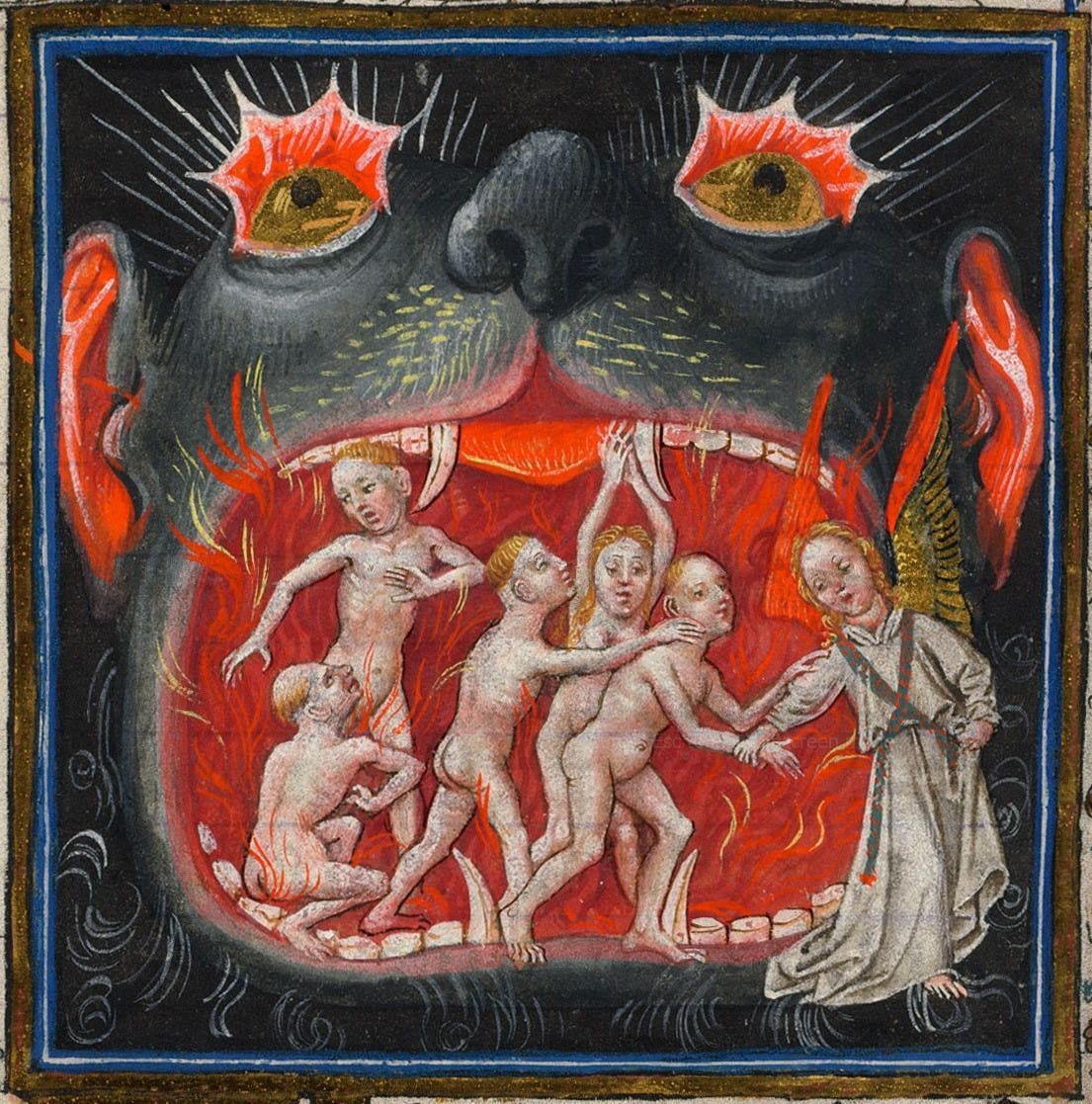The Massachusetts Medievalist on Atwood’s Latest (Spoiler Alert!)
As promised last time, the Massachusetts Medievalist will share further thoughts about Fourteen Days, edited by Margaret Atwood and Douglas Preston, but this discussion needs to address the ending of the “collaborative novel,”so if you’re planning to finish 14D any time soon, please just bookmark this post and return later.
(Hellmouth, Catherine of Cleves Hours, Morgan Library MS M.945, f.107r)
I must confess that I was completely surprised at the big reveal on day fourteen - that the characters are all ghosts. Even as the collection became more uncanny and surreal as it progressed, it never occurred to me that the narrators weren’t actually alive. But yes, they are all COVID victims who died in New York in March of 2020.
So I decided to re-read 14D. And it turns out I missed A LOT of clues that our narrators are all ghosts. There are so many, I can provide only a few examples. Missed clues first, (somewhat) medieval implications afterwards:
Day two: Whitney tells her story about the ghost at the Alamo. Vinegar asks her, “Do you think he knew he was dead?....Maybe he became a ghost because he didn’t know.” And Whitney responds, “Exactly what I thought….”(44). So there’s all this irony, retroactively applied, that Vinegar and Whitney don’t realize that they’re also dead.
Similarly, on Day Four, in response to a complaint about too many stories about death, Vinegar asserts that, “It’s not like we can keep ourselves from dying by not talking about it” (95). So all these ghosts up on the rooftop are telling stories about death; any strategies to “keep ourselves from dying” can’t apply since they’re already dead.
At the beginning of day thirteen, when Yessie will tell the riveting story of cutting off the rapist’s arm, she begins the chapter telling us that she is “sick and tired of my basement tomb” (295).
And all the various narrators who randomly show up and then kind of disappear? The Chinese exchange student (day nine), Arachne (day ten), the extremely bad comic (day eleven), and especially the immigrant family (day fourteen): the narrative lulls us into acceptance of these very strange cameos, but hindsight shows that these were supernatural figures as well, popping into the gathering for a limited time before moving on.
And finally, day thirteen is Easter Sunday, the day when the most famous dead person in Christianity ceases to be dead and rises into heaven. Yessie tells us that, “Dad said that tapping eggs with a loved one on Easter ensured that you’d see them again after death” (295). The climax of this “collaborative novel,” I would argue, is Yessie and her father’s reunion on the roof, when they’re both dead and he has lovingly, wonderfully, told the story of Skyling, the bird Yessie saved when she was a girl.
The medieval takeaway is the way that this text sees the natural and supernatural worlds as obviously permeable. The covert and overt references to Chaucer and Boccaccio (see previous post!) signpost the way back to the Middle Ages, but I found the easy access from the world of the living to the world of the dead the most medieval aspect of all. Yes, Dante’s pilgrim gets a tour of Hell. Yes, the “hell mouth” is a medieval artist’s favorite (see above). And it seems like apartment 2A, just upstairs from Yessie, is some sort of portal to the world of the dead.
She tells us at the end of day six that she is “more than ever convinced there were ghosts coming and going up there [in 2A], diligently at work on some otherworldly business” (152) and she constantly hears footsteps and the sounds of things dragged along the floor of that apartment. On day fourteen, when she takes the refugee family to apartment 2A to stay “until you work things out” (344), the grandmother asks, “Isn’t this how we came in?” (345). The supernatural access to the building is through 2A, not through the locked front door or the fire escapes. It’s a twenty-first century version of the access to the underworld that has featured not just in the European Middle Ages but throughout human history.
One comfort 14D provides is the idea that humans are humans, whether alive in this world or active in the next: once they realize they are ghosts, our narrators decide that they just want to keep telling stories (352).
Please leave a comment to share whether you were as surprised by the ending as I was!!


